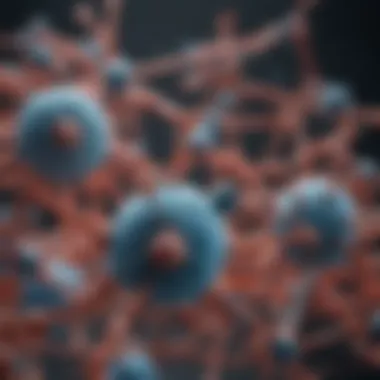Kisqali: Mechanism of Action in Cancer Therapy


Intro
Kisqali, known generically as ribociclib, has emerged as a significant player in the treatment of hormone receptor-positive breast cancers. Understanding its mechanism of action is essential for grasping its clinical implications and applications in oncology. This selective inhibitor of cyclin-dependent kinases 4 and 6 plays a vital role in controlling the cell cycle, particularly during the transition from the G1 to S phase. By halting this critical progression, Kisqali offers therapeutic potential, especially in patients where traditional treatment regimens face limitations.
The complexity of cancer biology necessitates a comprehensive exploration of how drugs like Kisqali function at the molecular level. In this article, we will delve into Kisqali's specific interactions with the cell cycle machinery, its pharmacodynamics, and how it integrates into existing treatment frameworks.
Key Findings
Summary of the Main Results
The primary findings from the studies surrounding Kisqali highlight its efficacy in inhibiting cyclin-dependent kinases 4 and 6. This inhibition leads to cell cycle arrest, effectively limiting cancer cell proliferation. Research has demonstrated that Kisqali not only holds promise when used alone but also when combined with aromatase inhibitors such as anastrozole or letrozole. This combination enhances treatment outcomes, offering improved overall survival rates and response durations.
Significance of Findings Within the Scientific Community
The findings surrounding Kisqali are significant for several reasons:
- They contribute to our understanding of intracellular signaling pathways that drive cancer cell growth.
- They provide insights into the potential for other therapeutic targets within the cell cycle.
- They open avenues for developing combination therapies that can mitigate resistance.
These aspects underscore Kisqali’s role as more than just a monotherapy, positioning it as a cornerstone in modern oncological treatment strategies aiming to target cell cycle dysregulation.
Implications of the Research
Applications of Findings in Real-World Scenarios
In clinical practice, the implications of Kisqali's action are increasingly apparent. Its incorporation into treatment regimens for hormone receptor-positive breast cancer has changed standard care protocols. Additionally, understanding the nuances of its mechanism allows healthcare professionals to personalize treatment strategies based on patient-specific tumor biology.
Physicians can better predict treatment responses and adjust courses accordingly, maximizing therapeutic efficacy while minimizing unnecessary side effects. Moreover, ongoing studies may lead to the repurposing of Kisqali for other malignancies exhibiting similar cell cycle dysregulation.
Potential Impact on Future Research Directions
The exploration of resistance mechanisms has become paramount as Kisqali continues to be utilized in clinical settings. Identifying pathways that lead to treatment failure could inform future research. Additionally, novel combination therapies that incorporate Kisqali with immunotherapeutic agents are gaining traction.
Research may unveil new targets or enhance existing models, paving the way for innovative treatment paradigms in oncology. The landscape is ever-evolving, and the role of agents like Kisqali will surely be a focus of continued investigation in the fight against cancer.
"The future of oncology lies not only in novel drugs but in understanding the mechanisms that influence their effectiveness."
In summary, a thorough understanding of Kisqali's mechanism of action provides critical insights into its therapeutic applications, ongoing research avenues, and its potential as a cornerstone of cancer treatment.
Intro to Kisqali
The study of Kisqali is essential in the realm of cancer therapeutics. It embodies a significant advancement in the treatment of hormone receptor-positive breast cancer. This introduction will highlight key attributes, its innovative mechanism, and its positioning in current cancer management strategies.
Kisqali, generically known as ribociclib, is a selective inhibitor of cyclin-dependent kinases 4 and 6 (CDK4/6). This specificity allows it to effectively interrupt the processes that lead to uncontrolled cell division, a hallmark of cancer. In terms of benefits, Kisqali provides a targeted approach. Unlike traditional chemotherapies, which often affect both healthy and cancerous cells, the targeted inhibition of CDK4/6 minimizes collateral damage to normal tissues. This can lead to better tolerance and improved quality of life for patients.
Moreover, understanding Kisqali's role necessitates a historical perspective on kinase inhibitors. The development of these inhibitors has significantly altered treatment landscapes. By placing Kisqali within this larger narrative, one can appreciate its contributions in context.
In summary, this section lays the groundwork for a comprehensive discussion about Kisqali’s mechanism of action, its clinical implications, and future potential in oncology. Both the molecular and therapeutic significance of Kisqali warrant a detailed exploration as we delve further into its mechanism and clinical applications.
Mechanism of Action
Understanding the mechanism of action of Kisqali is essential to appreciate its role in cancer therapeutics. The mechanism offers insight into how Kisqali selectively targets cancer cells, allowing for more effective treatment outcomes. By inhibiting specific kinases involved in cell cycle regulation, Kisqali addresses key processes that contribute to cancer progression.


This section examines two primary aspects: the role of cyclin-dependent kinases and the process of inhibiting CDK4 and CDK6. Delving into these topics reveals the complexities of how cancer cells proliferate and how Kisqali disrupts these processes. The effectiveness of targeting these pathways lies in the nuanced relationship between cell cycle control and hormonal influences in hormone receptor-positive breast cancers.
Role of Cyclin-Dependent Kinases
Cyclin-dependent kinases, or CDKs, are fundamental in regulating the cell cycle. They serve as crucial enzymes that, when activated, facilitate various transitions within the cell cycle. Specifically, CDK4 and CDK6 are integral to the transition from the G1 phase to the S phase, a critical step in cell division.
The activity of CDKs is regulated by cyclins, proteins that bind to the kinases and activate them. In normal cellular function, the regulation of these proteins is tight. However, in cancer cells, this regulation can be disrupted, leading to unchecked proliferation. By constantly pushing cells through the cell cycle, cancer cells can grow and divide more rapidly than normal cells.
Kisqali’s primary function is to inhibit CDK4 and CDK6. This inhibition is significant because it alters the normal progression of the cell cycle.
Inhibition of CDK4/
Inhibiting CDK4 and CDK6 leads to a halt in the cell cycle progression at the G1 phase. This action effectively prevents the cells from entering the S phase, where DNA replication occurs.
By blocking this transition, Kisqali disrupts the proliferation of hormone receptor-positive breast cancer cells. This inhibition not only slows down cell division but also allows for potential sensitization to other therapies, particularly hormonal treatments.
"Kisqali's inhibition of CDK4/6 transforms the therapeutic landscape, directly impacting treatment protocols for hormone receptor-positive breast cancer."
Overall, the inhibition provided by Kisqali exemplifies a targeted approach, aiming to diminish not only the tumor growth but also enhancing the effectiveness of established treatment regimes. The understanding of its mechanism of action is therefore paramount for clinical applications.
Biochemical Pathways Involved
In examining the mechanism of action of Kisqali, understanding the biochemical pathways involved is crucial. The interplay of various molecular components shapes how this drug affects cellular processes, especially in oncology. Biochemical pathways dictate cellular functions, including growth, division, and response to stimuli. Kisqali operates primarily by targeting cyclin-dependent kinases, which are central to cell cycle regulation. This section delve into the specifics of how these pathways function and their significance in cancer treatment.
Cell Cycle Regulation
The cell cycle is a series of phases that a cell goes through to grow and divide. It is meticulously regulated to ensure accurate cellular replication. Key proteins, such as cyclins and cyclin-dependent kinases (CDKs), facilitate this control. Kisqali specifically inhibits CDK4 and CDK6, preventing excessive cell proliferation. The inhibition of these kinases has the potential to halt the progression of the cell cycle at the G1 phase, which is often dysregulated in cancer cells.
- Importance of CDK4/6
CDK4 and CDK6 are vital for the transition from the G1 phase to the S phase of the cell cycle. By modulating these kinases, Kisqali interrupts this transition, leading to cell cycle arrest. This mechanism can significantly reduce the proliferation rate of cancer cells, particularly in hormone receptor-positive breast cancers, where these pathways are frequently altered. - Clinical Relevance
The clinical utility of targeting CDK4/6 goes beyond mere cell cycle arrest. This approach underscores the relationship between hormone receptors, such as estrogen, and cyclin-dependent kinase activity. In breast cancer, where hormone receptors drive tumor growth, inhibiting CDK4/6 can synergize with hormonal therapies, augmenting therapeutic efficacy.
By integrating the understanding of cell cycle regulation with the application of Kisqali, we can appreciate the drug's potential in improving patient outcomes. The inhibition of CDK4/6 not only curtails tumor growth but can also reverse resistance mechanisms that often develop in response to traditional hormonal treatments.
Impact on Hormone Receptor Activity
Hormone receptors play a significant role in various cancers, particularly breast cancer. Estrogen and progesterone receptors influence cell growth mediated by their hormones. Kisqali's action indirectly affects these receptors by modulating the endocrine signaling pathways.
- Mechanism of Interaction
The direct inhibition of CDK4 and CDK6 affects how hormone receptors function at the cellular level. When these kinases are inhibited, the downstream signaling that promotes cancer cell growth is also inhibited. This has a profound impact on the availability and activity of hormone receptors, leading to a potential decrease in tumor aggressiveness. - Enhanced Efficacy of Hormonal Therapies
Combining Kisqali with hormonal therapies like letrozole has shown promising results. This combination can address resistance pathways associated with hormonal therapies alone. The inhibition of CDK4/6 can enhance the efficacy of these treatments, providing a dual approach to managing hormone receptor-positive breast cancer.
"The interaction between hormonal therapies and CDK inhibition offers a new perspective on treating breast cancer, challenging the traditional therapeutic paradigms."
Understanding these pathways can lead to better-targeted approaches and improved patient outcomes in oncological care.
Pharmacodynamics of Kisqali
The pharmacodynamics of Kisqali (ribociclib) is critical to understanding how this drug impacts the treatment of cancers, especially hormone receptor-positive breast cancer. Pharmacodynamics studies the relationship between drug concentration and its effects on the body. In the case of Kisqali, its selective inhibition of cyclin-dependent kinases 4 and 6 (CDK4/6) leads to a cascade of intracellular reactions that ultimately affect the cancer cell cycle and proliferation. This section will elucidate the processes of absorption, distribution, metabolism, and excretion, which are all vital for understanding its overall efficacy.
Absorption and Distribution
Kisqali has a bioavailability of about 40% when administered orally. This means that a significant portion of the dose reaches systemic circulation, contributing to its therapeutic effects. After intake, Kisqali is absorbed fairly quickly, with peak plasma concentrations typically occurring within 6 to 12 hours post-administration.
Once in the bloodstream, Kisqali is highly protein-bound, approximately 70-80%, primarily to albumin and alpha-1 acid glycoprotein. This binding plays a crucial role in modulating its activity. The extensive binding reduces the drug's free concentration and may also influence interactions with other medications. Kisqali is distributed in various tissues, including the liver and lungs, suggesting that its effects may extend beyond the cancer cells targeted, impacting other systems as well.
Metabolism and Excretion


The metabolism of Kisqali occurs predominantly in the liver, involving cytochrome P450 enzymes, especially CYP3A4. This metabolic pathway is significant because it makes Kisqali susceptible to interactions with other drugs that either induce or inhibit CYP3A4. It is essential for patients to provide a comprehensive list of their medications to healthcare providers, as changes in drug levels can change its safety and efficacy.
Kisqali is primarily excreted as metabolites in the feces, with about 40% eliminated through urine. The half-life of Kisqali is around 32 hours, allowing for once-daily dosing, which enhances adherence to treatment regimens. In patients with hepatic impairment, the elimination of Kisqali can be prolonged, requiring careful monitoring and possible dose adjustments.
The pharmacodynamics of Kisqali not only highlight its effectiveness in cell cycle arrest but also underscore the importance of understanding absorption, metabolism, and excretion for optimizing therapeutic outcomes.
In summary, the pharmacodynamics of Kisqali showcases its targeted action against specific cellular mechanisms while posing challenges regarding drug interactions and patient management. Clinicians must be aware of these factors to effectively incorporate Kisqali into individualized treatment plans.
Clinical Applications
Understanding the clinical applications of Kisqali is critical, especially in the landscape of cancer treatment. As a selective inhibitor of cyclin-dependent kinases 4 and 6, it holds significant promise for managing specific subtypes of breast cancer. Investigating these applications helps delineate the scope of Kisqali's beneficial effects and its role in a treatment regimen. Moreover, it highlights important implications for patient outcomes, focusing on efficacy and safety.
Indications in Breast Cancer
Kisqali is primarily indicated for hormone receptor-positive breast cancer, which underscores its essential role in targeted therapy. This cancer subtype constitutes a significant portion of breast cancer cases, particularly among postmenopausal women. The mechanism of action involves the disruption of the cell cycle, preventing cancer cells from proliferating effectively.
Studies have shown that when used in combination with an aromatase inhibitor such as letrozole, Kisqali enhances outcomes significantly. It is especially valuable in first-line therapy for metastatic breast cancer. Clinical trials, including MONALEESA-2, have illustrated that Kisqali not only extends progression-free survival but also presents an acceptable safety profile.
Physicians consider these factors when choosing treatment paths. The response rate and overall survival benefits are critical for informing clinical decisions and guiding treatment plans for patients.
Combination with Hormonal Therapy
Combination therapies have become the cornerstone of modern oncology. The use of Kisqali in conjunction with hormonal therapies like tamoxifen or aromatase inhibitors targets different pathways effectively. This approach maximizes therapeutic efficacy while minimizing potential resistance mechanisms.
The rationale for combining Kisqali with hormonal agents lies in the complementary mechanisms through which they act. Hormonal therapies primarily reduce estrogen levels or block its effects on breast cancer cells. In contrast, Kisqali inhibits cyclin-dependent kinases, which are crucial for the cell cycle progression. This dual approach allows for a more potent attack on cancer cell growth.
Patients often experience improved outcomes, and the combination has garnered attention for its potential to manage adverse effects that may arise from high doses of single agents.
- Improved progression-free survival
- Reduced tumor burden
- Better tolerance profiles
Physicians must monitor patients closely for side effects and effectiveness. It's vital to adjust treatment regimens based on individual patient response.
"The development of combination therapies represents an evolution in oncological strategies, highlighting the importance of integrating various therapeutic modalities for enhanced patient outcomes."
Overall, the clinical applications of Kisqali signify a notable advancement in the management of hormone receptor-positive breast cancer. The modalities of its use demonstrate an innovative approach to tackling a complex and challenging disease. Understanding these applications assists healthcare professionals in optimizing care and improving quality of life for their patients.
Efficacy and Safety Profile
The efficacy and safety profile of Kisqali is crucial for understanding its role in cancer treatment, particularly for patients diagnosed with hormone receptor-positive breast cancer. Efficacy not only determines how well a drug can achieve its desired therapeutic effects but also influences treatment decisions and patient outcomes. Unlike some other therapies, Kisqali targets specific kinases that drive cancer cell proliferation, making it an important tool in personalized oncology.
Clinical Trial Results
Clinical trials are the backbone of establishing a drug's efficacy. Kisqali has undergone various clinical trials, notably the MONALEESA series, which have demonstrated significant improvements in progression-free survival and overall efficacy when combined with hormonal therapies like letrozole or tamoxifen. In these studies, clinical endpoints such as overall survival and the time to tumor progression were meticulously measured. Results showed that the combination of Kisqali with aromatase inhibitors led to a markedly higher percentage of patients remaining progression-free compared to those on hormonal therapy alone.
Key findings from clinical trials include:
- Progression-Free Survival: Patients receiving Kisqali displayed a statistically significant increase in progression-free survival compared to control groups.
- Overall Survival Rates: Long-term results indicated improved overall survival rates, reinforcing the drug's position as a frontline treatment option.
- Treatment Population: Trials primarily focused on postmenopausal women with HR-positive, HER2-negative breast cancer, establishing clear demographic applicability.
Adverse Effects and Management
Despite Kisqali's promising efficacy, its safety profile warrants attention. Adverse effects must be managed effectively to minimize their impact on treatment adherence. Common adverse effects include neutropenia, liver function test abnormalities, fatigue, and gastrointestinal symptoms such as nausea.


Effective management strategies are essential for maintaining the treatment schedule and improving the overall patient experience. Healthcare providers often recommend the following:
- Monitoring Blood Counts: Regular monitoring of blood counts is crucial for early detection of neutropenia. Dose adjustments may be required in case of significant dips.
- Liver Function Tests: Given the potential for liver function abnormalities, liver enzyme levels should be closely monitored throughout treatment.
- Patient Education: Informing patients about possible side effects can empower them to report symptoms early, allowing for timely management.
"The integration of rigorous monitoring and patient education can dramatically improve compliance and alleviate concerns pertaining to side effects."
Resistance Mechanisms
Understanding resistance mechanisms is crucial for optimizing the use of Kisqali in cancer therapy. Despite its efficacy, some patients may develop resistance to Kisqali, leading to treatment failure. This phenomenon not only hinders patient outcomes but also poses challenges in managing hormone receptor-positive breast cancer. Recognizing and addressing these mechanisms can enhance therapeutic strategies, allowing for prolonged responses to treatment and improved survival rates.
Molecular Adaptations
Molecular adaptations refer to the changes at the genetic or protein level that allow cancer cells to survive despite the presence of Kisqali. Various factors contribute to these adaptations, including genetic mutations and alterations in cell signaling pathways.
- Genetic Mutations: Certain mutations in the retinoblastoma protein (Rb) pathway, which is directly affected by CDK4/6 inhibition, can render cancer cells less responsive to Kisqali. When these mutations occur, the regulation of the cell cycle may become aberrant, allowing tumor progression despite treatment.
- Alterations in Cell Signaling: Cancer cells can also activate alternative signaling pathways to bypass the effects of Kisqali. For example, the upregulation of the phosphatidylinositol 3-kinase (PI3K) pathway has been implicated in promoting survival and proliferation, even in the face of cyclin-dependent kinase inhibition.
Overall, understanding these molecular adaptations provides insight into the complexity of cancer treatment and the necessity for personalized approaches to manage resistance effectively.
Strategies to Overcome Resistance
Developing strategies to overcome resistance mechanisms is essential for improving the effectiveness of Kisqali in clinical practice. Several approaches are being explored:
- Combination Therapies: Using Kisqali alongside other therapies, such as aromatase inhibitors or mTOR inhibitors, can target multiple pathways simultaneously, reducing the likelihood of cancer cells developing resistance. For example, combining Kisqali with letrozole has shown synergy in enhancing anti-tumor effects.
- Targeted Therapy Adjustments: Monitoring genetic changes in tumors may guide adjustments in therapy. If certain mutations emerge, switching to a different class of drugs or a targeted therapy that addresses the specific alteration may be necessary.
- Use of Biomarkers: Identifying biomarkers that predict resistance can direct treatment. For instance, the presence of specific mutations in the Rb pathway might indicate the likelihood of resistance, thereby guiding early intervention with combination therapies.
By focusing on these strategies, healthcare professionals can better navigate the challenges posed by resistance mechanisms. This proactive approach may lead to better outcomes for patients treated with Kisqali and other targeted therapies.
Future Directions
The exploration of future directions in the context of Kisqali's mechanism of action carries significant implications for the advancement of oncology. As the landscape of cancer treatment evolves, understanding how to optimize therapies is crucial. Kisqali, a selective inhibitor of cyclin-dependent kinases 4 and 6 (CDK4/6), plays a pivotal role in the treatment of hormone receptor-positive breast cancer. This introduces not only new challenges but also opportunities for research and clinical application.
Emerging studies focus on refining Kisqali's effectiveness. This includes examining patient-specific factors that may influence outcomes. Biomarkers can serve as predictors for response to treatment, allowing for more tailored approaches. Furthermore, understanding the molecular pathways impacted by CDK4/6 inhibition opens avenues for innovative therapeutic strategies. Integrating technological advancements in genomic profiling and personalized medicine stands as a promising direction.
Emerging Research Topics
Research continues to uncover novel dimensions in the application of Kisqali. Key topics include:
- Expansion into Other Cancer Types: Investigating the potential of Kisqali beyond breast cancer presents a compelling challenge. Studies are examining its effectiveness in other malignancies, potentially broadening its therapeutic scope.
- Understanding Resistance Mechanisms: An in-depth analysis of resistance pathways to CDK4/6 inhibitors is critical. Understanding these mechanisms can guide the development of next-generation inhibitors.
- Investigating Dosage Optimization: Researching optimized dosing regimens can enhance Kisqali’s efficacy while minimizing adverse effects, resulting in better patient outcomes.
Ongoing clinical trials and preclinical studies are essential to validate these emerging areas. By assessing how Kisqali can be utilized more broadly, the scientific community can shift the treatment paradigm significantly.
Possible Combination Approaches
Combining Kisqali with other therapeutic agents represents a key focus for future studies. Potential combination strategies may involve:
- Hormonal Therapies: Pairing Kisqali with tamoxifen or aromatase inhibitors is being explored. This could leverage synergistic effects, enhancing overall effectiveness against cancer cells.
- Targeted Therapies: Investigating combinations with other targeted therapies can provide insights into multi-faceted treatment approaches. For instance, integrating agents that target HER2 may yield significant benefits.
- Immunotherapy: Exploring how Kisqali could function alongside immune checkpoint inhibitors might reveal new strategies to stimulate the immune response in cancer treatment.
Combining treatment modalities not only adds to our therapeutic arsenal but also enhances our understanding of intricate cancer biology.
Epilogue
The conclusion of this article holds significant weight in comprehending Kisqali's impact on cancer treatment. It not only encapsulates the core insights shared throughout the text but also reinforces the importance of understanding the mechanisms by which this drug operates. Awareness of these mechanisms can empower healthcare professionals, researchers, and educators to make informed decisions about treatment options and the management of hormone receptor-positive breast cancer.
Summary of Key Points
In summarizing, we note several key elements regarding Kisqali and its role in oncology:
- Kisqali's Mechanism: Kisqali is a selective inhibitor of cyclin-dependent kinases 4 and 6, crucial for regulating the cell cycle, particularly in breast cancer cell proliferation.
- Clinical Relevance: Its application primarily targets hormone receptor-positive breast cancers, where CDK4/6 inhibition can significantly slow tumor growth.
- Pharmacodynamics: Understanding how Kisqali is absorbed, metabolized, and excreted helps in managing dosing regimens effectively.
- Resistance Mechanisms: Identifying resistance pathways aids in developing strategies for overcoming treatment challenges.
- Future Research: Emerging research topics and potential combinations with other therapeutic agents could enhance efficacy.
By integrating these points, we encapsulate the multifaceted role that Kisqali plays in oncology, which will aid ongoing research and treatment methodologies. The continued exploration of its mechanisms and the adaptions within cancer biology remain paramount in the quest for more effective cancer therapies.







